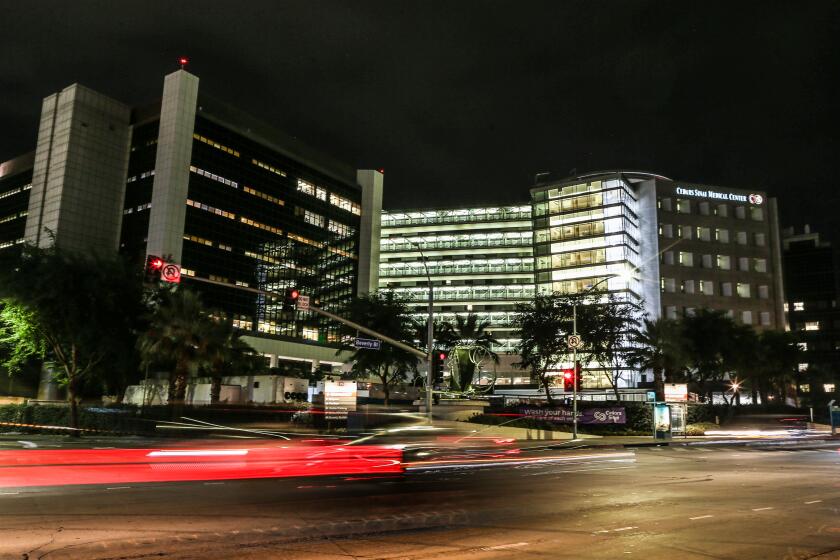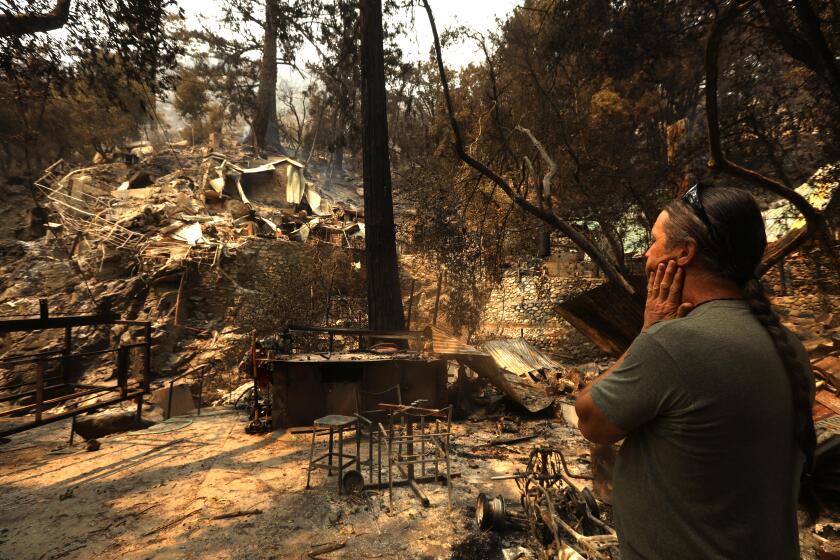A section of the San Andreas fault close to L.A. could be overdue for a major earthquake
Southern California could be overdue for a major earthquake along the Grapevine north of Los Angeles, according to a sobering new study by the U.S. Geological Survey.
The research found earthquakes happen there on average every 100 years. The last major temblor occurred 160 years ago, a catastrophic geological event that ruptured an astonishing 185 miles of the San Andreas fault.
The land on either side of the fault has been pushing against the other at a rate of more than 1 inch a year since 1857, the researchers said, accumulating energy that will be suddenly released in a major earthquake, when the land along the fault would move by many feet.
“So you expect that amount of accumulation of energy will be released in the future in a large-magnitude rupture, somewhere along the San Andreas,” said the lead author of the study, USGS research geologist Kate Scharer.
A repeat of the 1857 earthquake could damage aqueducts that ferry water into Southern California from the north, disrupt electric transmission lines and tear up Interstate 5, whose Grapevine section runs on top of the San Andreas fault at Tejon Pass.
Central Los Angeles could experience a couple of minutes of shaking, which could feel like a lifetime compared with the 1994 Northridge earthquake, which shook for roughly 15 seconds.
“This would be more broadly felt across the basin,” Scharer said. “It would impact our ability to be a world-class city.”
There has been a long drought of major earthquakes on the southern San Andreas fault, which has slowly been accumulating strain as the Pacific plate grinds northward against the North American plate. The seismic stress has been building up without relief since the presidency of Franklin Pierce.
The quake will probably be something few Southern Californians have ever experienced. Of the 10 earthquakes Scharer and her colleagues found in the past 1,200 years, the most common magnitude was about magnitude 7.5.
Such an earthquake would tear up land along the fault’s length and displace it by an average of 9 feet.
The site studied by Scharer and her colleagues is next to Frazier Mountain at the top of Tejon Pass, close to the meeting point of Los Angeles, Ventura and Kern counties. Unlike other sections of the southern San Andreas, this region — about a 100-mile section of the fault — had not been studied in detail before, and scientists did not know what earthquakes occurred there before the 19th century.
So Scharer and other scientists undertook the most intensive study of its kind in this section of the San Andreas fault, where researchers could hear the roar of traffic from Interstate 5. Trenches were dug deeper than ever before at this location to better understand the history of earthquakes there.
“To get 1,200 years of records, we have to do lots of excavations and go quite deep,” Scharer said.
They found 10 major earthquakes over a 1,000-year period. But “it doesn’t happen like clockwork,” Scharer said. There was once a gap of only 20 years between two major quakes. On the other end, there was a gap of about 200 years between quakes.
So while this part of the San Andreas fault could be overdue for a large earthquake, it’s also possible it could be decades longer before the Big One strikes. Of the identified gaps between earthquakes, three took longer than 160 years to strike this part of the San Andreas again.
“Longer gaps have happened in the past, but we know they always do culminate in a large earthquake. There’s no getting out of this,” Scharer said.
There was one possible silver lining. The most common magnitude they found at this site, 7.5, means that the 7.9 earthquake experienced in 1857 was unusually strong.
In fact, of the newly discovered earthquakes, there was only one other estimated at 7.9 — one that struck around 1550.
The conclusion that 7.9 earthquakes there are relatively rare could be good news, said Caltech seismologist Egill Hauksson, who was not involved in the study.
“That means it released a lot of energy on the fault,” Hauksson said of the 1857 temblor. It also could explain why the southern San Andreas fault has been so quiet since then.
The difference between a 7.5 and a 7.9 earthquake is significant, Scharer said. A 7.5 earthquake produces roughly 15 times less energy than a 7.9. And while a 7.5 earthquake displaces land along the fault by an average of 9 feet, the bigger earthquake moves land by 20 feet.
“A road can handle a couple of feet of displacement,” Scharer said, “but when you start to get into a dozen feet, it’s a real challenge.”
The study was published online Thursday in the Journal of Geophysical Research, a publication of the American Geophysical Union.
The 1857 quake was so powerful that the soil liquefied, causing trees as far away as Stockton to sink. Trees were also uprooted west of Fort Tejon. The shaking lasted one to three minutes.
The San Andreas fault is 30 miles from downtown Los Angeles, but big earthquakes on the San Andreas fault are expected to heavily shake the nation’s second largest city.
A simulation of a possible magnitude 8 unzipping from Monterey County into L.A. County shows heavy shaking waves reverberating across a wide swath of the Los Angeles Basin and nearby valleys, whose soft soils can trap shaking energy like Jell-O.
Because the 1857 quake hit when the population was so small, only two people were killed.
Other parts of the San Andreas fault could also rupture. Further southeast of the Cajon Pass, such as in San Bernardino County, the fault has not moved substantially since an earthquake in 1812, and further southeast toward the Salton Sea, it has been relatively quiet since about 1680 to 1690.
“The springs on the San Andreas system have been wound very, very tight,” Thomas Jordan, director of the Southern California Earthquake Center, said at an earthquake conference last year, adding that the southern San Andreas is “locked, loaded and ready to roll.”
In 2008, the U.S. Geological Survey simulated a magnitude 7.8 earthquake on the southern San Andreas that would begin at the Salton Sea and spread west toward the San Gabriel Mountains in Los Angeles County. Such a quake could cause more than 1,800 deaths, 50,000 injuries, $200 billion in damage and severe, long-lasting disruptions.
The collapse of five high-rise steel buildings, with 5,000 people inside them, was seen as possible in this USGS scenario, as would be the destruction of 50 concrete buildings; 800 people might be in completely collapsed concrete buildings, and 7,000 more in those that partially collapsed. About 900 brick buildings could be irreparably damaged.
Some cities, like Los Angeles and Santa Monica, have responded by passing laws requiring owners retrofit some of the most vulnerable buildings known to engineers. Santa Monica recently moved forward on a sweeping law that would require evaluations, and if needed, retrofits of wood apartments, brittle concrete buildings and flawed steel towers.
RELATED: Check if your building is on Santa Monica’s earthquake study list (scroll down)
Twitter: @ronlin
ALSO
Often overlooked, brick chimneys pose hazards in quakes
Preliminary quake map shows fault lines under schools, hotels, homes
Get ready for a major earthquake. What to do before — and during — a big one
UPDATES:
9:45 a.m.: This post was updated with context of how other parts of the San Andreas fault could rupture, a 2008 simulation of the damage a 7.8 earthquake could do to Southern California, and efforts by cities like Los Angeles and Santa Monica to require owners to retrofit seismically vulnerable buildings.
6:35 a.m.: This post was updated with a photo and additional detail on the 1857 quake.
This post was originally published at 4 a.m.
More to Read
Sign up for Essential California
The most important California stories and recommendations in your inbox every morning.
You may occasionally receive promotional content from the Los Angeles Times.









